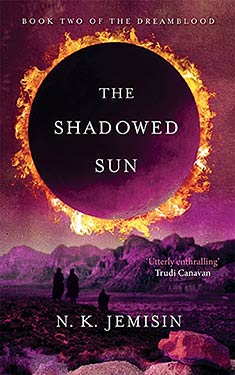NK Jemisin
Completed 6/13/2020,
Reviewed 6/13/2020
5 stars
I loved this
book immensely, more so than The Killing Moon, it’s predecessor. It tackles deeper, darker issues, such as
incest, abuse, and rape. It’s not a
direct sequel; it takes place ten years after Moon and a few of the characters recur
in this volume. It’s the same universe,
though, with the same dreaming magic for healing and ending life. The city-state where the action took place in
Moon has been conquered by the city-state it intended to conquer. There are all sorts of political machinations
among the conquerors and the conquered.
And somehow through the darkness and politics, I found myself completely
enrapt in the lives of the main characters.
It’s a shame this book wasn’t nominated for awards, as its predecessor
was. I thought it was written better and
the magic used and described better, though this latter part is probably
because I didn’t need the first half of the book to learn it as I did in Moon.
 Hanani is
the first woman who has become an apprentice Sharer, in fact she is the first
woman ever accepted into the Hetawa, the organization that deals with dreaming
magic. As a Sharer, her primary focus is
healing through dreams. She and her
mentor Mni-inh are assigned to a squad that goes out to the desert to try to
engage with Wanahomen, the heir apparent to the throne, and the barbarian tribe
he’s come to lead, to overthrow the city’s occupiers. In the meantime, there is a dreaming plague
taking over the city. It kills people while
they are asleep as well as the Sharer, or apprentice, or acolyte who is working
their dreams. The cause is not known but
the casualties keep mounting. This causes
fear among the general population which is already near the tipping point of
revolution against the invaders.
Hanani is
the first woman who has become an apprentice Sharer, in fact she is the first
woman ever accepted into the Hetawa, the organization that deals with dreaming
magic. As a Sharer, her primary focus is
healing through dreams. She and her
mentor Mni-inh are assigned to a squad that goes out to the desert to try to
engage with Wanahomen, the heir apparent to the throne, and the barbarian tribe
he’s come to lead, to overthrow the city’s occupiers. In the meantime, there is a dreaming plague
taking over the city. It kills people while
they are asleep as well as the Sharer, or apprentice, or acolyte who is working
their dreams. The cause is not known but
the casualties keep mounting. This causes
fear among the general population which is already near the tipping point of
revolution against the invaders.
I thought
Hanani was an awesome character. As the
first woman in the Hetawa, she is constantly up against sexism to such a degree
that she must dress and act like a man to perform her functions. She is doubted by the Superior and many of
her colleagues. Only her mentor gives
her the support she needs, becoming like a father to her. When she goes on the mission to the desert,
she is kept there, as sort of a hostage, to show good faith and trust between
the Hetawa and Wanahomen. There she has
all sorts of difficult encounters with the barbarians, the selfish Prince, death,
destruction, and her own heart and mind.
Through all this, her character development is so good, I became completely
enmeshed in her emotions and frustrations.
Wanahomen
was another great character. As the heir
apparent, he is full of bile over the death of his father by the Hetawa. Thus, he hates them. However, he is soon won over to their
side. That process is really well
developed. Telling any more gives too
much away. I also really liked Mni-inh,
Hanani’s mentor, and Yanassa, Wanahomen’s first lover and the mother of his
child. Yanassa is smart, sassy, and
helps Hanani cope with being the woman that the Hetawa had repressed.
The violence
towards women is very difficult to read.
It is not gratuitous violence as in a regular action novel. It is all very necessary to character development
and the plot. The book acknowledges it,
discusses it, subverts it, and most importantly, does it in a way that does not
perpetuate it (this is almost a direct quote from NK Jemisin’s blog on sexual
violence from 2012). I thought it was
very well done and very provocative.
I had to
give this book five stars out of five.
It really grabbed me. It had me
reading the last third of this five hundred page book very late into the
night. I simply had to find out how
Hanani would come to be at peace after all the troubles she had to bear. This is an excellent book, but as with
everything I’ve read of Jemisin, it is very dark. She may have won the Hugo and Nebula for The
Broken Earth series, but her previous books are also excellent. I have to say that Jemisin has become one of
my favorite authors.
No comments:
Post a Comment